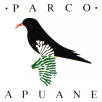|
|
||||
|
|
|
10th European Geoparks
Conference Langesund (Norway), 15th-21st September 2011 |
||
|
|
||||
|
|
VIDEO OF THE AWARD CEREMONY An historical video to remember an historical event: the entrance of the Apuan Alps Regional Park in the European and Global Geoparks Networks, under the auspices of Unesco. Saturday 17th September 2011, in Langesund (Norway). |
|
||
|
|
PHOTO CHRONICLE | |||
|
|
||||
|
|
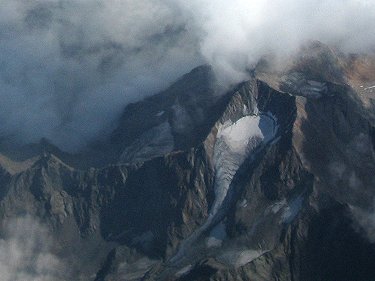 |
Thursday 15.09.2011
Departure from Florence. When the sky clears up, evocative landscapes of the Alps become visible from the plane. In the picture a small valley glacier with its short ablation zone. An anticipation of Norwegian imposing glacial morphology. |
||
|
|
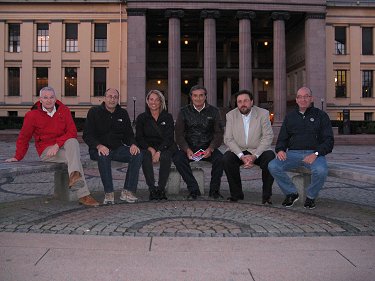 |
Thursday 15.09.2011 After a smooth flight we arrived on time in the capital, Oslo. We took a short tour of the city. In the picture, the Park delegation in front of the University. |
||
|
|
 |
Friday 16.09.2011 Journey from Oslo to Lagesund by bus. The landscape is characterized by conifer woods and patches of cultivated lands, but whaleback-shaped landforms prevail. The ice sheet from the Ice Age (Inlandsis) greatly influenced the morphology of the whole Scandinavian region. |
||
|
|
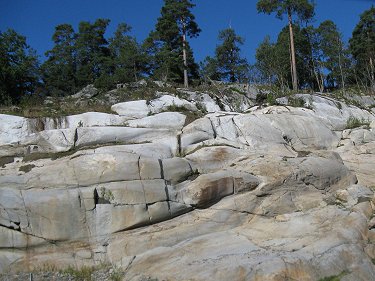 |
Friday 16.09.2011 Journey from Oslo to Lagesund by bus. A substrate smoothed by glacial exaration sometimes outcrop underneath the vegetation. It is a large stretch of "roches moutonnées". |
||
|
|
 |
Friday 16.09.2011 Journey from Oslo to Lagesund by bus. The sea penetrates deep into the fjord near Larvik. This is another characteristic of Scandinavian glacial morphology. We are already inside Gea Norvegica Geopark. |
||
|
|
 |
Friday 16.09.2011 Journey from Oslo to Lagesund by bus. We arrive at the venue of the E.G.N. Conference, the Conference Centre of the Lagesund Quality Hotel & Resort Skjærgården, just in time for the check-in and the official opening of the event. |
||
|
|
 |
Friday 16.09.2011 The afternoon is dedicated to authorities' greetings and opening remarks. In the picture, the main conference room during the speech given by Nickolas Zouros and Patrick Mc Keever, Coordinator and Vice-Coordinator of the European Geoparks Network respectively. |
||
|
|
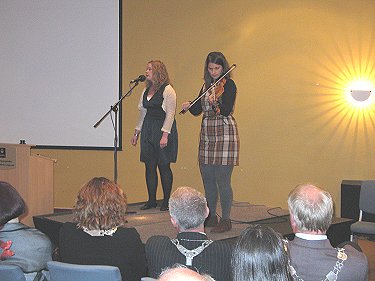 |
Friday 16.09.2011 Ceremonial formalities end with a show of Norwegian folk music performed by two young and expert musician and singer. |
||
|
|
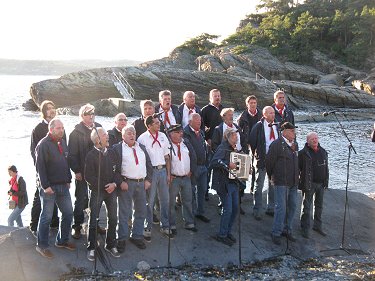 |
Friday 16.09.2011 A second show of pop music is held on Lagesund sea shore, in Steinvika, in a palaeontological geosite of great value. A local chorus performs north-American music, which was exported to Norway through trade and the traditional activity of ship building. |
||
|
|
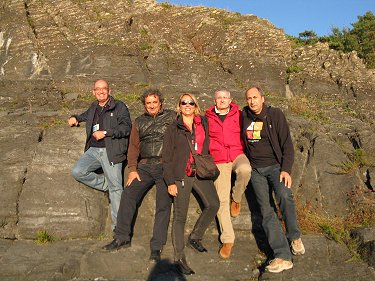 |
Friday 16.09.2011 All the Conference attendees listen to the singing exhibition with attention and interest. In the picture, the delegation of the Park of the Apuan Alps sitting on natural tiers made of rocks. |
||
|
|
 |
Friday 16.09.2011 The area of Steinvinka is a suggestive place, especially at sunset. Small whaleback shaped landforms outcrop near the shore. These "rocky whales" are the result of sea erosion on stratified and slightly sloping Ordovician sea sediments. |
||
|
|
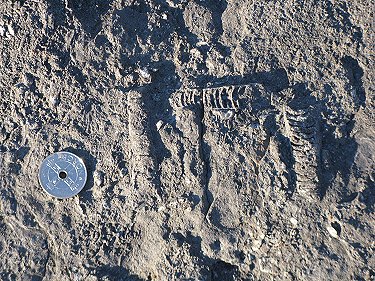 |
Friday 16.09.2011 A careful look shows fossils of animals which lived 461-451 million years ago, such as brachiopods, trilobites, graptolites and nautiloid cephalopods (Endoceras?), as those showed in the picture. |
||
|
|
 |
Saturday 17.09.2011 The second day of the E.G.N. Conference, dedicated to aspiring geoparks, sees the presentation of the report entitled "Enhancing geological heritage in the Apuan Alps aspiring geopark (Italy)", written by Alessia Amorfini, Antonio Bartelletti and Giuseppe Ottria. In the picture, the geologist Ottria illustrates the Apuan Alps Park report. |
||
|
|
 |
Saturday 17.09.2011, 8.30 p.m. FINALLY GEOPARK!!!!!! The official picture during the proclamation. In the picture, the Park delegation with (from left to right) Ibrahim Komoo (Coordinator of the Asia Pacific Geoparks Network), Nickolas Zouros (Coordinator of the European Geoparks Network) and Margarete Patzak (Unesco, Division of Ecological and Earth Sciences) |
||
|
|
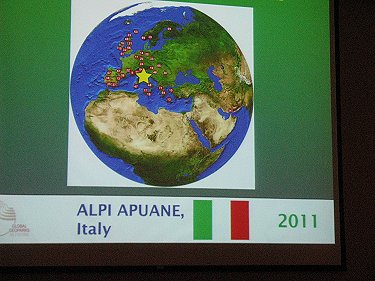 |
Saturday 17.09.2011, 8.30 p.m.
FINALLY GEOPARK!!!!!! In the meantime, the map of the world appears on the screen. There is a “star” on the Apuan Alps to signify a new Geopark in the European and world constellation. |
||
|
|
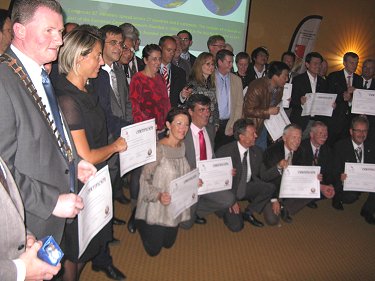 |
Saturday 17.09.2011, FINALLY GEOPARK!!!!!! The representatives of the new members of the Global Geoparks Network posing for the official picture. The Apuan Alps are represented by Alessia Amorfini, on the left. |
||
|
|
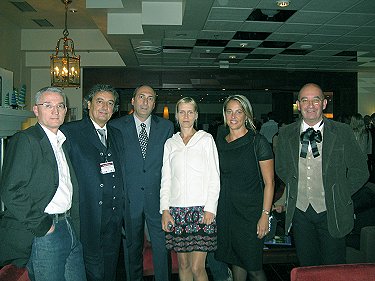 |
Saturday 17.09.2011
FINALLY GEOPARK!!!!!! The Park delegation with one of the evaluators, Martina Paskova, after the award ceremony. |
||
|
|
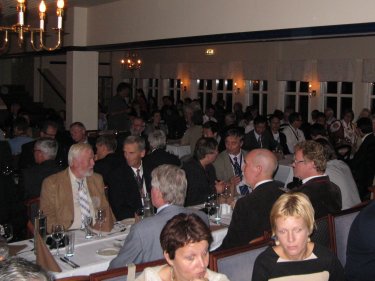 |
Saturday 17.09.2011 FINALLY GEOPARK!!!!!! The participants during the official dinner of the 10th Conference. |
||
|
|
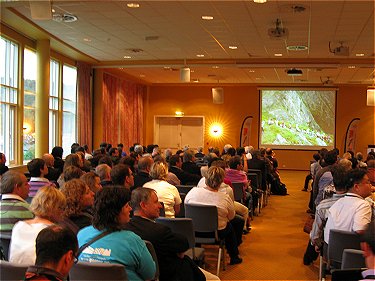 |
Sunday 18.09.2011 The third day of the EGN Conference went smooth. The closing ceremony took off at 4.30 p.m. sharp. |
||
|
|
 |
Sunday 18.09.2011. Greetings and acknowledgments were followed by a short presentation of forthcoming meetings of the Network during 2012. The 5th International GGN Conference will be held at the Unzen Geopark in Japan in May, whereas the 11th EGN Conference will take place at the Arouca Geopark in Portugal in September. |
||
|
|
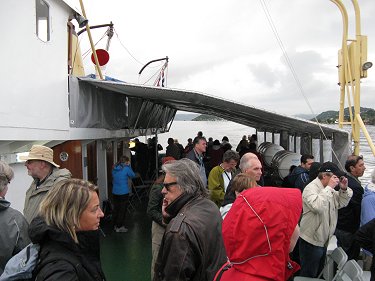 |
Monday 19.09.2011 First ferry trip from the shores of Kragerø village to Jomfruland island. The President of the National Park of Cilento and Vallo di Diano, Amilcare Troiano, in the foreground, was among the participants. |
||
|
|
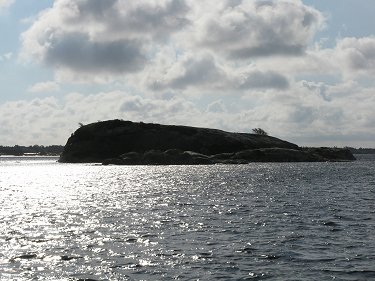 |
Monday 19.09.2011 Not surprisingly, landform glacial morphology is characterized by the typical backwhale shape. |
||
|
|
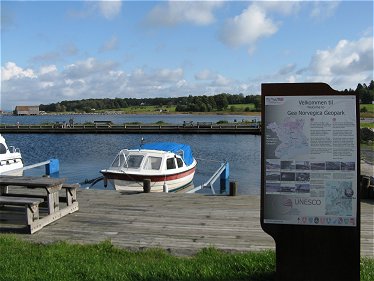 |
Monday 19.09.2011 Jomfruland is a 7,5 km long and 1 km wide island which runs parallel to the continental coast. It is considered one of the main geosites of Gea Norvegica Geopark, as it coincides with the maximum expansion of the Scandinavian icecap, registered during the cold oscillation occurred 12,000 years ago before deglaciation. |
||
|
|
 |
Monday 19.09.2011 Gea Norvegica Geopark takes care of visitors and, in our case, of Conference participants with expert guides, who not only provide geological information about the island, but also explain popular traditions of and legends about places and natural elements of the area. |
||
|
|
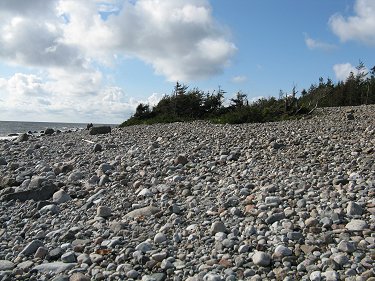 |
Monday 19.09.2011 A glacial deposit outcrops towards the open sea, on the south-east shore of the island. It is a beach made of big “alien” pebbles. Jomfruland formed thanks to the emersion of the “Ra-moraine” (from the High Norwegian word “ra”, which means “ridge”). It is the part which emerged from the terminal moraine, left behind by the Scandinavian ice sheet (inslandis) before its final withdrawal. |
||
|
|
 |
Monday 19.09.2011 The beach is a large stretch of rounded pebbles consisting of different kinds of rocks (granites, syenites, larvikites, gabbros, gneisses, sandstones, etc.), eroded and transported here by the ice sheet (inslandis). |
||
|
|
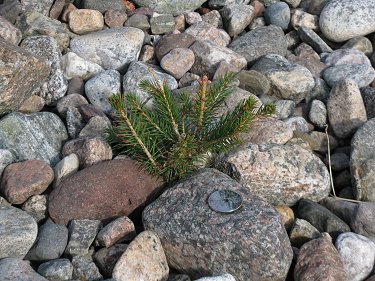 |
Monday 19.09.2011 Vegetation tries to grow on pebbles on Jomfruland beach. Norway Spruce (Picea abies) trees and shrubs, lashed by sea winds, bend backwards and almost bow down to the ground. Some young spruce fir specimens try to colonize soils which will prove hostile and inhospitable. |
||
|
|
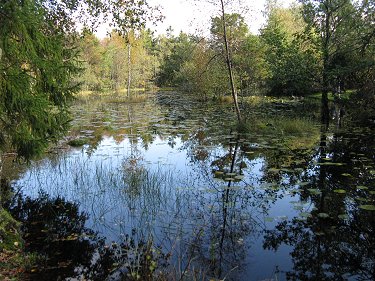 |
Monday 19.09.2011 Glacial pebbles and Aeolian sands are not found everywhere on the island. As a matter of fact, its central part is characterized, in a slightly lower position, by argillaceous deposits of glacial origins. They create an impermeable layer enabling the formation of small lakes and marshes, partly fed by precipitation and partly by heavy seas. |
||
|
|
 |
Monday 19.09.2011 Jomfruland humid areas are characterized by remarkable flora and vegetation, which would have been of interest to the Apuan Park naturalist, Dr. Emanuele Guazzi. The picture shows a dense population of lily pads |
||
|
|
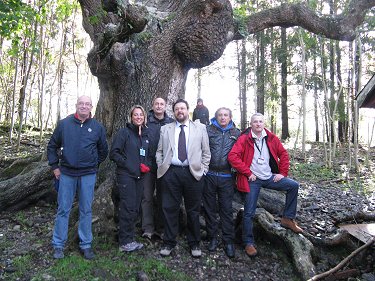 |
Monday 19.09.2011 A picture of the whole Park delegation under the boughs of a monumental ash tree (Fraxinus excelsior) which is said to be the biggest in Norway. |
||
|
|
 |
Monday 19.09.2011 At the end of the trip to Jomfruland island, the boat takes the participants back to Kragerø harbour. |
||
|
|
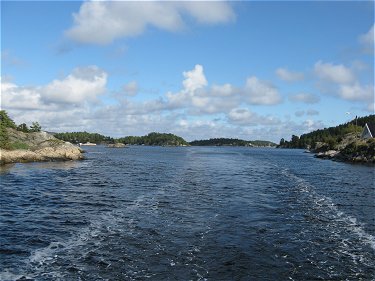 |
Monday 19.09.2011 The white wake of the boat stretches into Kragerø fjord. |
||
|
|
 |
Tuesday 20.09.2011 Second bus trip to familiarize with the most ancient and the youngest geological features of Gea Norvegica Geopark. The first stop is at the Rognstranda geosite, which is easily accessible and provided with information panels. The geosite is situated on the sea shore, in the inner part of Rogns fjord. |
||
|
|
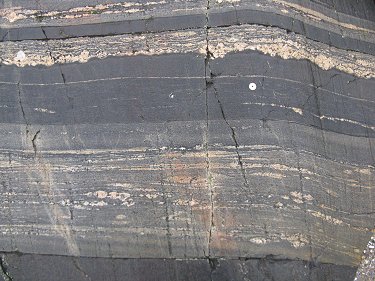 |
Tuesday 20.09.2011 Outcropping rocks are mainly made of gneisses, which formed 1,500 million years ago and were part of a Precambrian mountain range. |
||
|
|
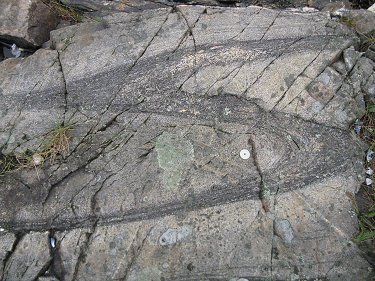 |
Tuesday 20.09.2011 Gneisses underwent ductil deformation processes, which testify to the complex tectonic vicissitudes leading to the formation of these ancient ultrametamorphic rocks. |
||
|
|
 |
Tuesday 20.09.2011 Gneisses are sometimes “cut” by basalt dykes of various dimensions and periods. However, all of them date back to a period after the formation of the main ultrametamorphic rock. |
||
|
|
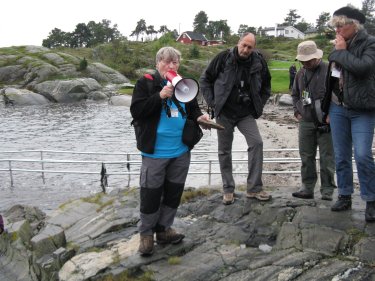 |
Tuesday 20.09.2011 The geologist of Gea Norvegica Geopark explains the ancient geological features of Rognstranda, among which are (to the East) limestones and schists, formed from the Cambrian to the Silurian. A deep fault divides ancient rocks from Palaeozoic stones. |
||
|
|
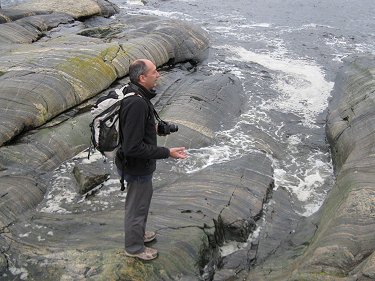 |
Tuesday 20.09.2011 The geologist Giuseppe Ottria shows the structural features of Rognstranda outcrop to the Park delegation. |
||
|
|
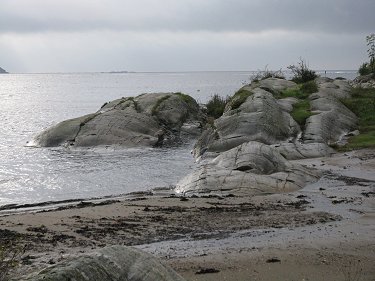 |
Tuesday 20.09.2011 Rognstranda geomorphology is characterized by a rocky coast smoothed by the erosion of the Ice Age, with "roches moutonneés" and grooves created by glacial motion. |
||
|
|
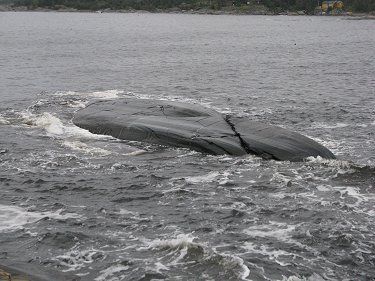 |
Tuesday 20.09.2011 |
||
|
|
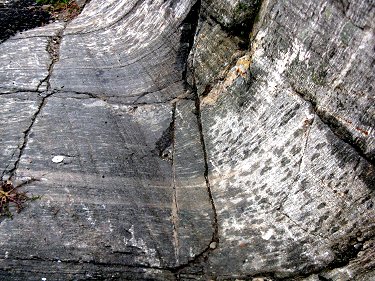 |
Tuesday 20.09.2011 Glacial grooves, testifying to glacial motion, are still visible along the smooth surfaces of gneisses. |
||
|
|
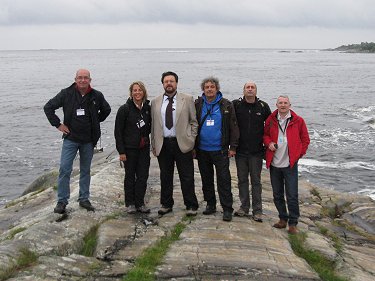 |
Tuesday 20.09.2011 The whole delegation posing for the official picture at Rognstranda geosite in Gea Norvegica Geopark. |
||
|
|
 |
Tuesday 20.09.2011 A bus takes conference participants to Århus Farm, situated near Skien, within Gea Norvegica Geopark. Besides quality crop cultivation, the farm is characterized by reproductions of landscapes and rural settlements of the Norwegian Iron Age (500 B.C.–800 A.D.). |
||
|
|
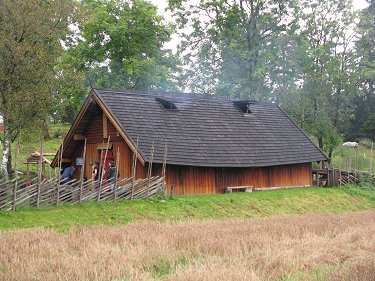 |
Tuesday 20.09.2011 The Iron Age farm is a highly suggestive building which has been faithfully and thoroughly rebuilt. Its shape recalls the “Celtic huts” of the Apuan Alps and the nearby Apennines which were used as barns and storerooms for tools. |
||
|
|
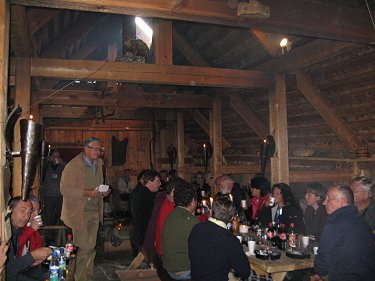 |
Tuesday 20.09.2011 A light meal is served inside the Iron Age farm. The place is foggy because of the fire lit on braziers lying on the ground, without neither hood nor chimneys. The smoke goes out from openings in the roof slowly. |
||
|
|
 |
Tuesday 20.09.2011 We are still in the area of Skien. The cultural trip continues with the visit to the ruins of Kapitelberget Medieval church, built in the 12th century. The local limestones used to build the walls date back to the Silurian age and are particularly rich in fossils, especially in crinoids. |
||
|
|
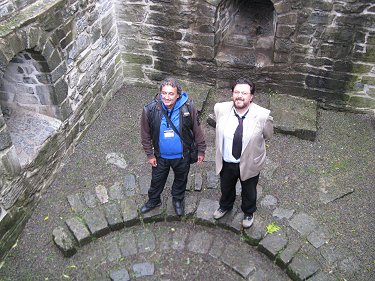 |
Tuesday 20.09.2011 In the picture, President Nardini and Vice President Putamorsi in the crypt.
|
||
|
|
 |
Tuesday 20.09.2011 Skien is famous for being Henrik Ibsen hometown (1828-1906). In the picture, the garden and the house where the Norwegian writer and his family lived in the second half of the 19th century. |
||
|
|
 |
Tuesday 20.09.2011 Stop in the county of Telemark, more precisely in Brevik, one of the best preserved harbour towns of the Age of Sail. The guide in a lamplighter outfit takes conference attendees on a short tour. |
||
|
|
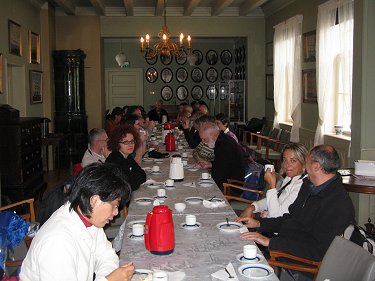 |
Tuesday 20.09.2011 In the afternoon, refreshments are served in the old hall of the Brevik Maritime Museum. |
||
|
|
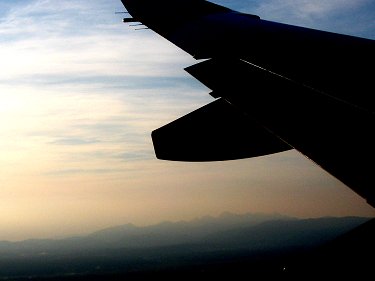 |
Wednesday 21.09.2011 Flying back to Florence. One last turn before landing. On the background, the familiar skyline of the Apuan Alps. |
||
|
|
||||
|
|
||||
|
|
||||
|
|
||||
|
|
||||
